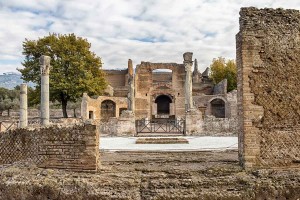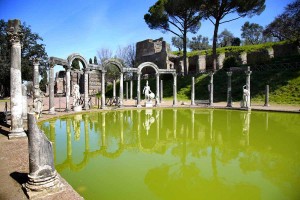
©Bigstock.com/salvo77na
There was an abundance of imperial residences in the Roman Empire, as the name suggests, but none of them ever matched the dimensions and the unbelievable splendour of Hadrian’s Villa. Villa Adriana in Tivoli, located approx. 30 km northeast of Rome, comprises of at least 125 hectares of land according to estimations – partially covered by buildings, partially covered by cultivated gardens. Hadrian used this place to let all the impressions he gathered on his many journeys come together. This UNESCO World Heritage Site even served as a major inspiration for all further developments of the art of garden design in the Renaissance. Extensive excavations are still carried out on this humongous area to this day.
Origin history
Hadrian reigned as 14th Roman Emperor from 117 AD until his death on 10 July 138 AD. During his tenure he extensively travelled all provinces of his empire, particularly Egypt and Greece, where he collected an abundance of ideas and impressions for his summer residence, which would also serve as his old-age residence in later years. Construction and extension works on Hadrian’s Villa lasted a whopping 16 years. Its site was chosen strategically well. While there already was a tried and tested road connection to Rome, Via Tiburtina, its ideal location allowed transportation of materials to the construction site via the river Anio, which is connected directly to the Tiber.
Over the course of the years an old republican villa was extended drastically now including Greek and Egyptian elements, accompanied by comprehensive extensions of the water supply. Several brand-new buildings were constructed illustrating a gradual departure from the then-popular angular architecture. Gardens also played an important role in Hadrian’s thinking. The extensive dimensions of the green areas remained unmatched for a long time.
Decay and rediscovery
After Hadrian’s death the villa fell into the hands of his successors yet was more and more forgotten before eventually being exploited. The foundation of Constantinople lead to the removal of furnishing and marble, the facility then served as a storage and extraction site decaying more and more. During the Middle Ages almost nothing was left of the building’s former opulence.
However, Early Renaissance saw Villa Adriana in Tivoli experience just that. The rediscovery over the course of the 15th century turned the site into a major source of inspiration for the contemporary art of garden design. Baroque gardens in particular tried to match Hadrian’s ideal. At the same time, excavations finally got started and pillages were at least reduced. Ultimately, only around 300 works of art could be found and were brought to various museums. To this very day around a third of the entire plot remains undiscovered as excavations are still in process.
What awaits you during your visit

©Bigstock.com/vladacanon
We recommend a guided tour of the entire site of Villa Adriana in Tivoli. You get to visit all ruins, gain extensive insights into the various gardens and get to walk through the underground supply corridors. A look at the comprehensive aqueduct systems reveals the technological progress in transporting fresh water from the mountains to the villa. Here are some of the buildings and facilities of Hadrian’s Villa you’ll come across on your tour:
- Piazza d‘Oro: Situated in the south part of the facility, the courtyard presumably served as the site of large receptions and banquets. Marble floors and Egyptian pillars extend around the big garden with water basin.
- Thermae: The two thermae – Grandi Terme and Piccole Terme – were modelled after classic Roman ideals, thereby evoking familiar memories of comparable excavation sites. While the smaller one was meant for the emperor, his family and guests – precious stuccowork might remind you of its erstwhile splendour – the bigger of the thermae with floor heating was for personnel only.
- Philosopher’s Chamber: Despite its name, the original purpose of this hall remains a mystery – maybe you can discover decisive clues during your tour? The rectangular room with alcoves and a semi-circular apsis might have been a library or a meeting hall.
- Pecile: Reach the Pecile through the large gate on the north side of Villa Adriana in Tivoli. This rectangular column corridor established around an artificial pond offered protection from heavy wind and adverse weather as well as complete peace and solitude. Roman medicine prescribed a two-mile walk – seven rounds – through such a corridor after lunch.
- Canopo: Hadrian’s journeys repeatedly lead him to Egypt, where he marvelled at the might of the river Nile. The Canopo is evocative of the eponymous canal that connected the Nile and Alexandria. The water basin was adorned by rows of pillars, statues and depictions of Greek gods.
- Heliocaminus: Aside from the thermae facilities for guests and personnel mentioned earlier, there also was another thermal bath, the Heliocaminus. The warmth of the sun came in through glass windows, double-floored walls and floors were heated. The steam escaped through the lumen, a hole in the centre of the ceiling.
- Teatro Marittimo: Despite what its name might suggest, no theatre performances took place here. Hadrian retreated to this miniature domus on an artificial island to meditate. This area was only accessible via two drawbridges controlled from the island offering the ruler full privacy.
- Palazzo Imperiale: The emperor’s palace dates back to the first construction phase of Hadrian’s Villa and is widely regarded as being the oldest building on the entire plot. This imposing seat of power originally comprised a total area of approx. 50,000 m². All living and representative rooms were appointed with humongous, comprehensive mosaics.
Old ruins and replicas of original statues meet the remains of what were once imposing gardens, now having partially regained their former glory thanks to tender restauration with a keen eye for details. It fascinated and inspired over the course of thousands of years like only a select few other buildings could. Enrich your trip to Rome with these and other ZAINOO travel suggestions. We wish you an awesome visit to this astonishing UNESCO World Heritage Site!